30 June, 2010
22 June, 2010
World Cup Algerian Merguez
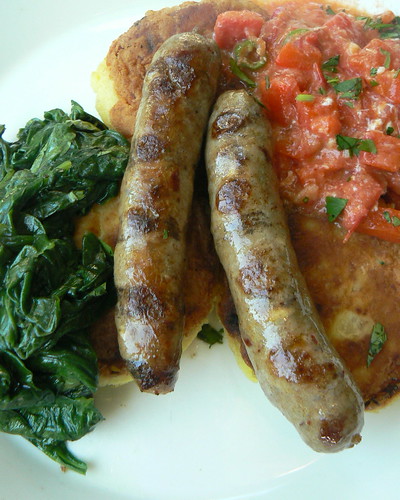
What's the best way to get inside your opponent's head? Find out what they eat. Merguez anyone? World Cup is on and the American's have a crucial test against Algeria tomorrow. So will the play be spicy? Let's find out.
I looked at a bunch of recipes and I concluded a good Merguez is just lamb and harissa. Harissa is a condiment of peppers garlic and spices used throughout Northern Africa (referred to by some as the Mahgreb).
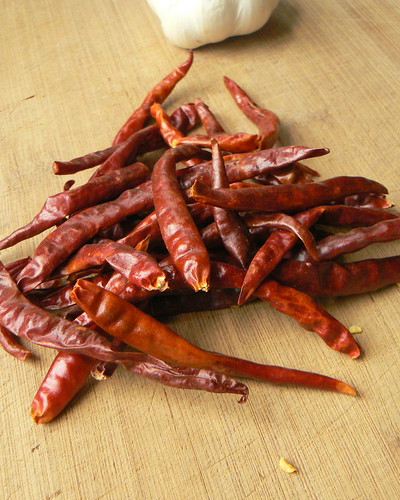
For the Harissa I re-hydrated some dry red peppers, crushed some garlic,

And toasted some spices.
Everything went into the blender with some olive oil and some water and presto!
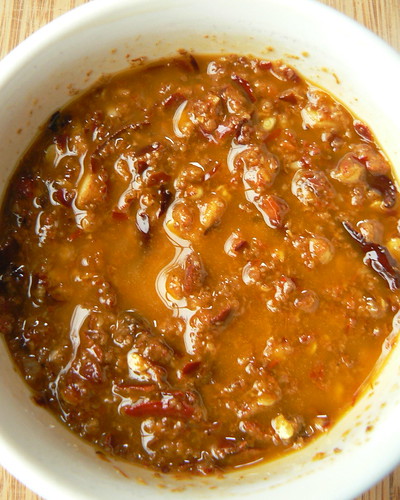
Harissa.
Here's the quantities:
10g (25-30) small dry red peppers
12g 2T whole coriander
12g 2tsp whole cumin
24g 4 cloves of garlic
1/2 cup 200 ml EV Olive Oil
Cold Water as needed.
The peppers. For better flavor you can toast them in a dry skillet until fragrant, or quickly blanch them in oil. Following either way, soak them in very hot tap water until soft about 15 minutes. Toast and grind the whole spices then throw everything into the blender. Only add cold water if you need to get things moving, up to 2T (30 ML)
Since I'm making this harissa for the sausage, I'm holing off on the salt. If you want to use it as a condiment, salt to taste (TT), my taste is about 1/2tsp (3g)
For the Sausage I use 2tsp (14g) of salt for 2 pounds (900g) of ground lamb. add all of the prepared harissa and 2T (12g) of fresh thyme. Mix well, add a little cold water to smooth it out.
Try to find some sheep's casing to stuff (pork casing are haraam), or make meatballs and call them keftas.
These sausages are spicy but not overly so, my kids ate them. You can serve them with couscous, but I also found a potato pancake (Makoud) recipe that was kinda fun. Sorry Algeria, I love your sausage but I'm going to have to root for the US on this World Cup.
Cheers.
References (all links to WorldCat, so you can find these books at a library near you)
The Great Book of Couscous, by Copland Marks
North African Cooking, by Hilaire Walden
The Soul of a New Cuisine, by Marcus Samuelsson
The Oxford Companion by Davidson
18 June, 2010
08 June, 2010
South African World Cup Braai
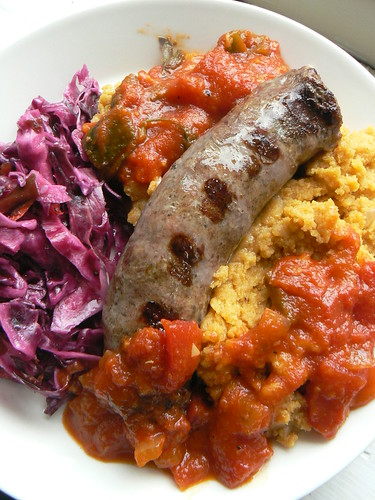
In this Episode
World Cup Boerewors (Farmer's Sausage)
Pap
Train Smash
Rhubarb Fluff
Remembering Merle Ellis, "The Butcher"
Where are you going to be when the World Cup kicks of this Friday? I'll be at work, but hopefully they'll have the TV tuned to the matches. I'm not a huge sports fan, but I really like international sporting events. They are a chance to get away from my small suburban existence and see a diverse world coming together to play. They are also a chance to eat and celebrate and a chance to learn how different peoples party. Every corner of the world has its sausage, so during this year's World Cup, I want to discover a few.
I start with host country South Africa. Boerewors is the sausage that is standard for any Braai (Barbecue)in South Africa. Sounds kinda like bratwurst huh? I don't how how to prounouce it but I suspect if you use an Austrailian dialect with a Dutch accent you'll come pretty close. Boer means farmer and wors is sausage (btw Bratwurst means grilling sausage). I found many different recipes, but most were made up of a combo of beef and pork heavily spiced with coridaner. I found a couple of formulas that called for bacon, I think that sounds good but since I was out (I'm curing some right now), here's what I did:

900g/2lbs Chuck roast coarsely ground
450g 1lb Pork shoulder coarsely ground
21g salt
10g Coriander, whole (toasted if possible)
5g Black pepper
2 whole cloves
pinch of mace
5g milk powder (optional helps with texture)
60ml/2oz/ 1/4cup white wine vinegar
60ml/2oz/ 1/4cup water
Grind spices with salt and beat into meat mixture. Then add milk powder and liquids, continue to beat until mixture comes together, maybe two minutes.
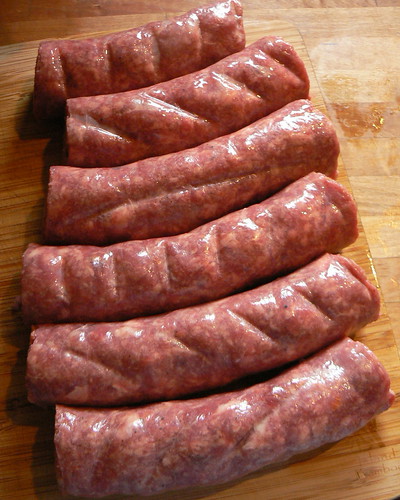
Stuff into hog casings, leave in a continuous length. Try to let the sausage rest a day before grilling. Cut to desired lengths and cook.
So what to serve with sausage? Starch and gravy of course. Mielie Pap is just as it sounds, corn porridge, or as it's pronounced in Italy, polenta. As in many cultures, pap is a staple in South African cuisine. White corn meal is typically used, but all I had was yellow so I went with that. I softened one chopped medium onion in some butter then added three cups of chicken stock and a teaspoon of salt. Once it came to a simmer I slowly stirred in 2 cups of corn meal. And I stirred and I stirred. once it started to bubble, the mixture seemed smooth but kinda bland.
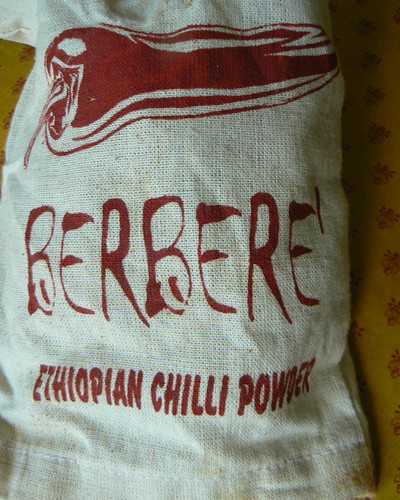
I unstrapped and removed my Authentico Foodie Helmet, and phoned in East Africa for a little help. Berbere, a spice mixutre from Ethiopia consists mainly of dried red chillies, cardamom, cumin, fenugreek, coriander and other lesser variations. It's a spicy red curry powder. A tablespoon of this added a nice zip to my porridge.
Finally a sauce. I hate saying gravy, but it is what it is. I found several different names for the same sauce: Sous, Sjeba, Sheba, and my favorite, Train Smash. It's onions, tomatoes, green peppers and brown sugar stewed together. Sounds a lot like ketchup. But it's not, it's better.
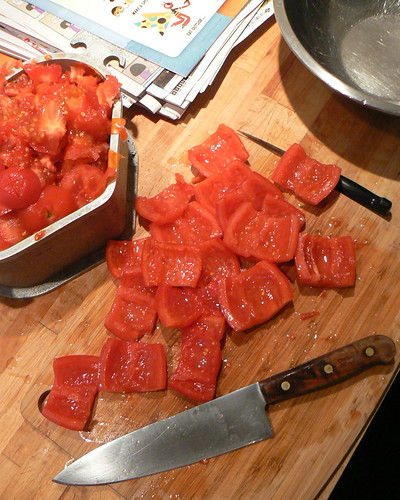
I chopped up a bunch of tomatoes, added that to 3 cups of tomato sauce and put it into a hot satoir that contained one chopped onion, already softened. I roasted and skinned a poblano pepper, chopped it and threw it in. Once that mixture had cooked down a bit, I drew it out with about a cup of stock added a bouquet garni and let it simmer some more. For the sweetness I dribbled in a couple of ounces of molasses, for zip I sprinkled some hot paprika. After an hour it was about right. Let's eat.
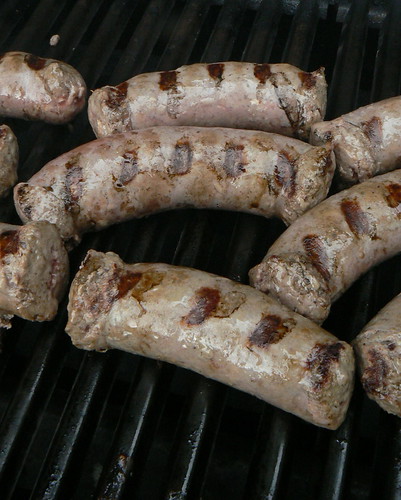
For desert we shuffled back to the Midwest for a seasonal favorite strawberry shortcake. Remember when strawberries were seasonal?
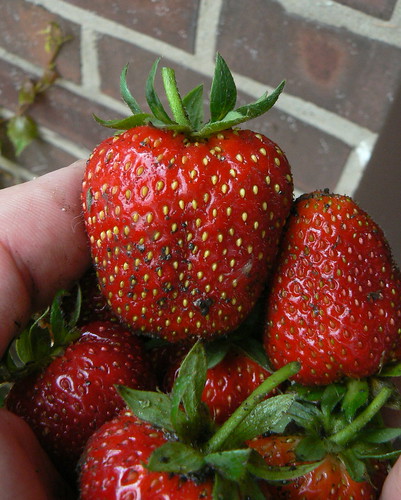
Our patch has gotten large enough to produce berries in quantity. Bonne Femme made up some shortcakes, and I made some rhubarb fluff to go with. For the fluff I chopped up some rhubarb, sprinkled it with a heavy hand of sugar, some salt and a splash of tequila. I let it sit overnight in the fridge.
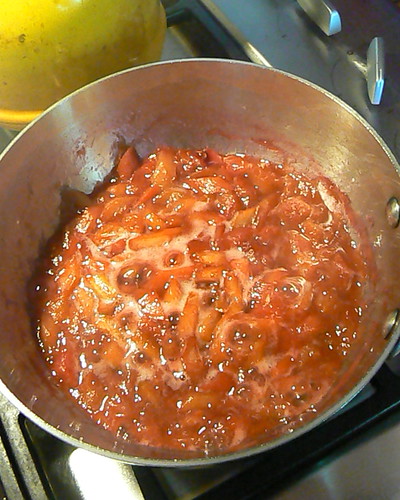
The next day I threw it in a pot with some water and cooked it down. The mash went for a whirl in the Cuisinart and then strained.
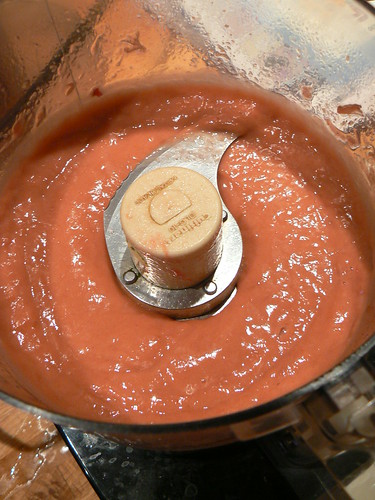
I folded the purée into some whipped cream and voilà, fluff.
let's eat.
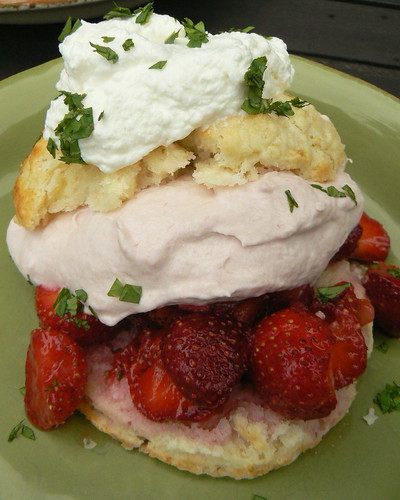
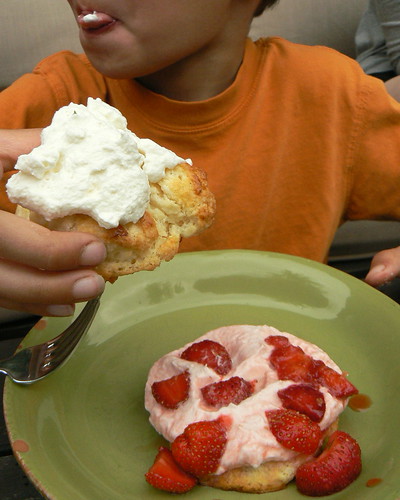
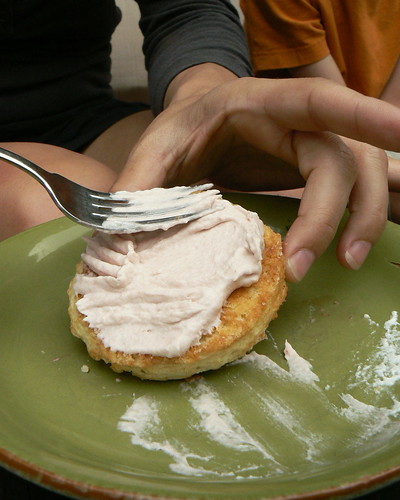
A fine feast for World Cup. What are you going to fix?
Merle Ellis, The Butcher, 1934-2010.
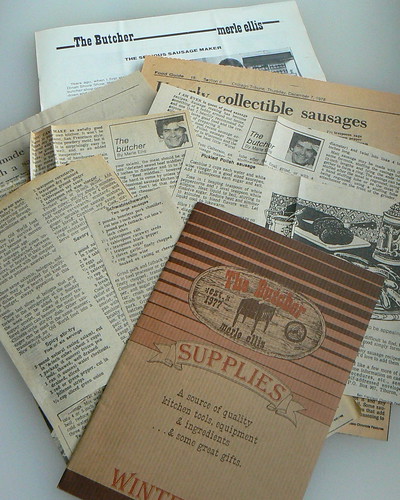
When I was researching boerewors, the first recipe I found was in an old newspaper article written by Merle Ellis. In the 70's and 80's he wrote a nationally syndicated column titled "The Butcher." Can you imagine a weekly feature dedicated to home butchering and sausage recipes? He wrote hundreds of articles. He wrote several books and had a TV show called "Cut-up and Cook." He was the Original Rock Star Butcher. What I liked most about is writing was his plain straight forward approach and he could tie a recipe to a story. His recipes had soul, something that's missing from a lot of modern cookbooks. Mr. Ellis passed away in January (read the Obituary here). I became familliar with him when I found the items pictured above stuffed into two separate sausage books at used books sales. It's hard to find information about him on the internet, he stepped out of the lime light many years ago. On the blog I'm Mad and I Eat, there's a nice account of a chance meeting the author had with Mr. Ellis, and a recent comment on the the post The Ultimate Breakfast Sausage Recipe attests to kind interactions with Mr. Ellis as he worked behind the counter at a market in Petaluma, CA.
I have a copy of his first book Cutting-Up in the Kitchen. In it he dedicates the book to his wife:
"To Neva, Without her help it could have not been done. Without her it wouldn't have been worth doing."
Food and love forever, we should all be so lucky.
Cheers.

Resources used in this article (Links to WorldCat.org)
Another good Boerewors recipeThe Sausage-Making Cookbook by Jerry Predika
About Berbere, Cooking with Herbs and Spices by Andi Clevely et AL.
General Information about SA cuisine, The Oxford Companion to Food by Alan Davidson
03 June, 2010
02 June, 2010
Caul of May

Recipes (sorta)
Crépinettes des volailes et épinards
Gayettes de Provence
May came and went in a wink, but this time I headed the call of the poppy. May 1998 I was in France for the first time. The ditches in SW France were clogged with these red weeds. I couldn't imagine anyone wanting to live anywhere else. Superlative proclomations aside, I managed to land in the Chicago Southland and in our little suburban garden I wanted to grow poppies. Year after year the rabbits took care to foil my French fantasies until this year: Four fine pops.
Alas the poppies remind me of recipe that has watched May come a go several times. My mom had a copy of Colors of Provence, from the library. In it I found recipe calling for a mixture of pork and poppy greens wrapped in caul fat called calliettes. The author was kind enough for those of us without easy access to young shoots to subsitute any early green such as chard or spinach. I thought what a perfect way to celebrate Spring, sausage and greens wrapped wrapped in fat. But wait, what's caul fat?
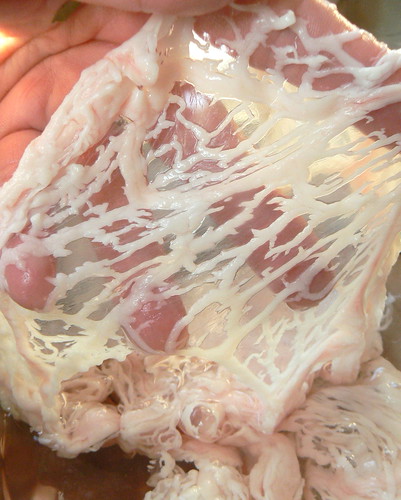
The Oxford Companion immediatelty turns to Jane Grigson to describe caul:
"The caul is a large web of fat which encloses the intestines. It is not the fattly frill called mudgeon or mesentery that actually holds the intestines together - what the French call fraise - but a cloth like semi-transparent sheet about a metre square, or a little less. If you see it at all in a butcher's shop, it will most likely be hanging in a greyish-yellowy droop, looking like a worn out dishcloth. Unappetising. Something you would never think of asking for unless you knew its value and usefulness..."
Ask.
I stopped by my local abattoir (T&J Meat Packing, Chicago Heights) and nervously asked. The man behind the counter twisted a doubtful wince then walked into the back. You see I have been going here for several years and have never seen caul in the cases, I didn't want to make him go in the back...He returned with what looked like a knot of kitchen twine with a piece of shoe leather attached. I said, "Yeah that looks like it." He said "Ok, you want the spleen (the shoe leather)?" Uh no, thanks.

Calliettes, Crépinettes, Gayettes, oh my.
While I was sure the recipe from Colors was pure gold, I wanted to find other recipes. I quickly learned that caillettes was part of a larger family of fat wrapped treats including crépinettes, gayettes and boulettes. At this point I will not claim to be an authority on what is what, but the different names seem to be based on the size and shape of the sausage. Caillettes, French for bird's eggs are small and round, Crépinettes are larger, flat and either round or triangular, Gayettes rectangular bricks and boulettes small like large bullets. I'm sure some Franco-Foodie nerd could ring in and school me on the exact differences but that's all I could find. Pork and Sons was the only other cookbook I could find with a caillettes recipe, but all my other sources were lousy with Crépinette recipes so I started there.

If you are to believe old French cookbooks, the crépinette can be made up a multitude of ways but it is always served with a puréed (pronounced, mashed) potatoes. I liked Pork and Sons suggestion of a shreaded potato cake so I went with that. I used Chicken and spinach for my first crépinette. Here are the quantities I used:
10oz (285g) of Spinach
1 medium yellow onion chopped
1 lb (455g) Chicken ground
1t (7g) Salt
2g White pepper
2g brown mustard seed
2g coriander
5g milk powder
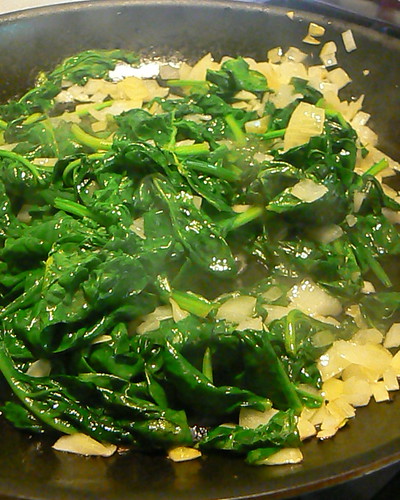

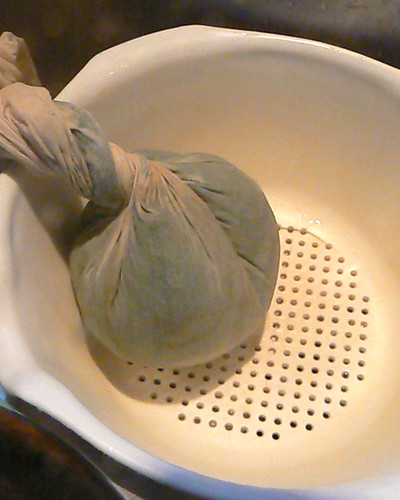
First I cooked down the spinach and onion in a little butter, then I wrung out all the moisture I could out of the cooked spinach mixture.
I combined the spinach and onion with the rest of the ingredients and beat them a bit with the paddle on my stand mixer.
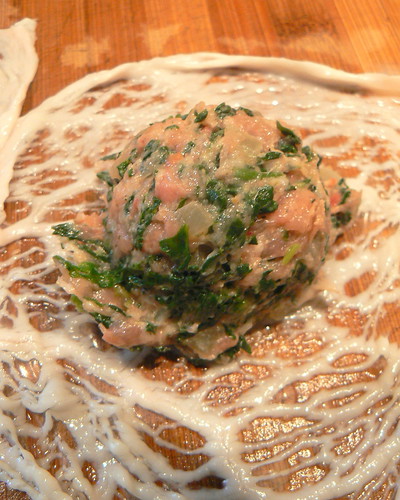
I cut the caul in to 5 x 5 squares and put a few of ounces of the mixture in the middle.

Once wrapped, I dusted the packages with a little flour, browned them in a pan, and finished them in a hot oven.

Yield: 8 Crépinettes
Note: Caul, as I mentioned, comes by the fist, one will suffice for this recipe, but try to get a couple in case they are busted up. I never paid never more than sixty cents a pound for this throw away item, but then not everyone lives as close as I do to the Heights. Once you get your caul, soak it in several changes of water, it will keep in the fridge, in water, for a couple of weeks.
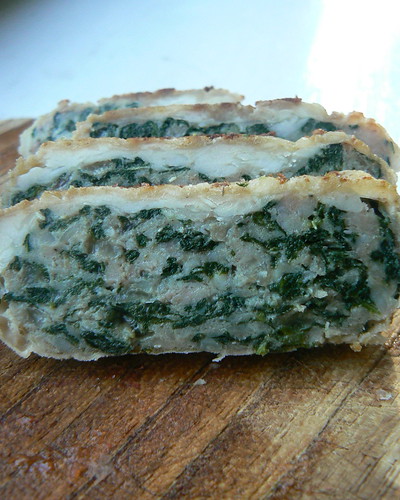
Leftover crépinette is very good for lunch

Gayettes de Provence

In her book Charcuterie and French Pork Cookery, Grigson suggests a recipe for Gayettes de Provence, hey that's liver pâté wrapped in caul, I got a recipe for that, yo. Both Grigson and Larousse romanticize the gayette as a French picnic staple smeared on bread with a bit of butter and mustard. (If that's not love, I don't know what is.)
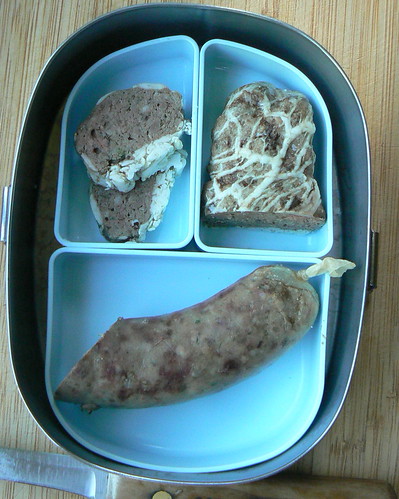
Ok before I give this next recipe I have to apologize. I didn't work out a yield, and ended up with a lot of pâté. I used maybe two cauls then stuffed the rest into a casings. But I will give you this recipe anyway just because it tastes so darn good. Once made you can put this pâté in caul or casings or even a loaf pan, it doesn't really matter, in the end it ends up smooshed on bread.
Gayette de provence (de MAC) BETA
1.5 lb liver
1.5 lb Pork shoulder
1 lb Pork fat
1/2 lb pork heart (or just use more liver)
1/2 lb ice crushed
32g salt
10g white pepper, ground
3g ginger ground
3g mustard ground
2g coriander ground
1g mace ground
15g garlic minced
Fresh herbs: Thyme, parsley, hyssop, TT
To make this sausage, I took and emulsified approach. I coursely ground the liver, shoulder, heart and fat separately. I combined the shoulder, heart, fat and ice on a sheet tray and put it into the freezer until crunchy.


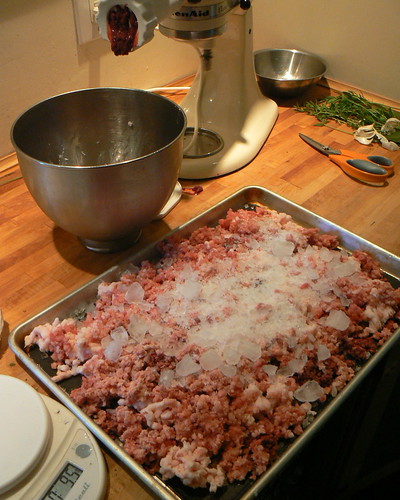
I put the liver into the mixing bowl the ground the chilled mixture through the fine plate on top.

Using the paddle I beat this mixture for a few minutes. During this time I added all the other spices.

I formed the gayettes into logs and wrapped them in caul.
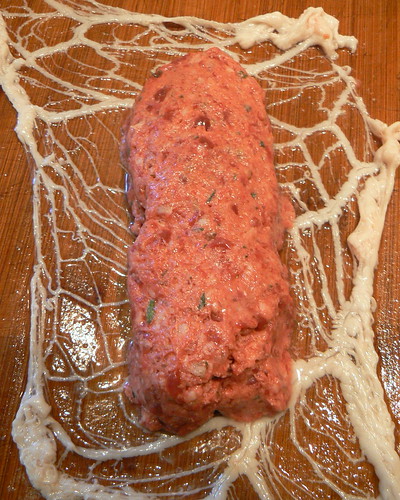
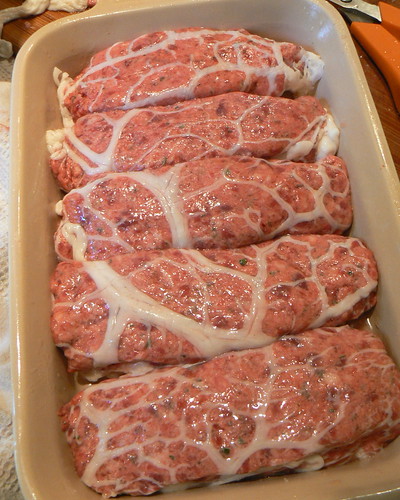
Cook them 15-20 minutes in the oven to an internal temp of 155F. Chill in an ice bath then refrigerate until ready to use.
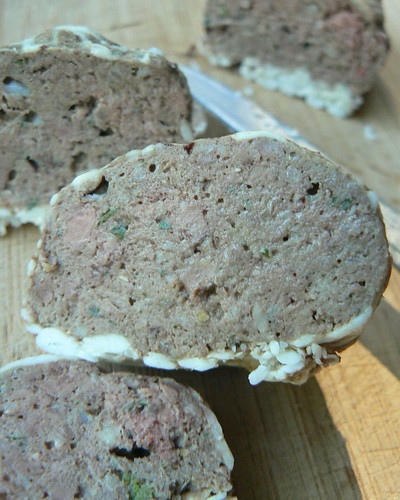
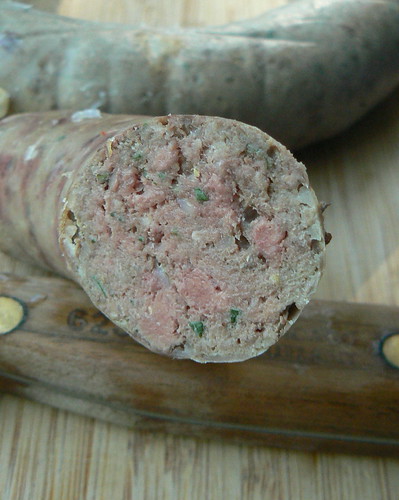
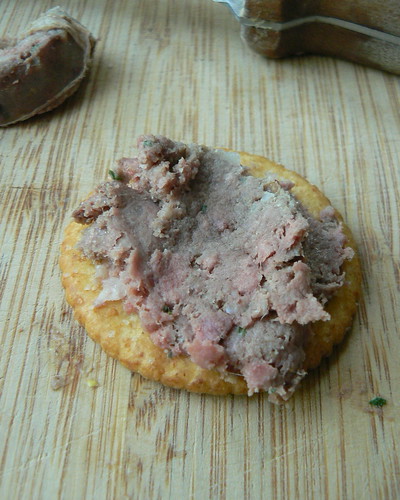
Gayette my favorite way, for breakfast.
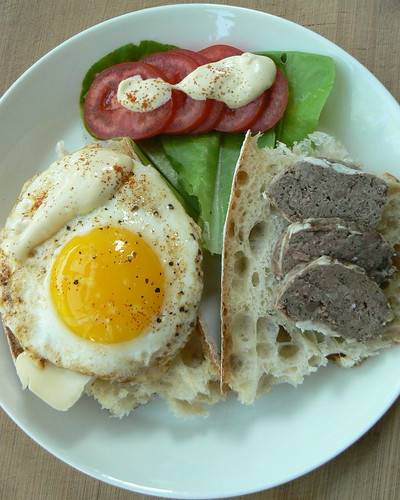
Oh May where have you gone? Time to eat.
Cheers.
References (all links to WorldCat, so you can find these books at a library near you)
Colors of Provence by Beihn
The Oxford Companion by Davidson
Pork and Sons by Reynaud
Charcuterie and French Pork Cookery by Grigson
Larousse by Montagné
French Provincial Cooking by David

